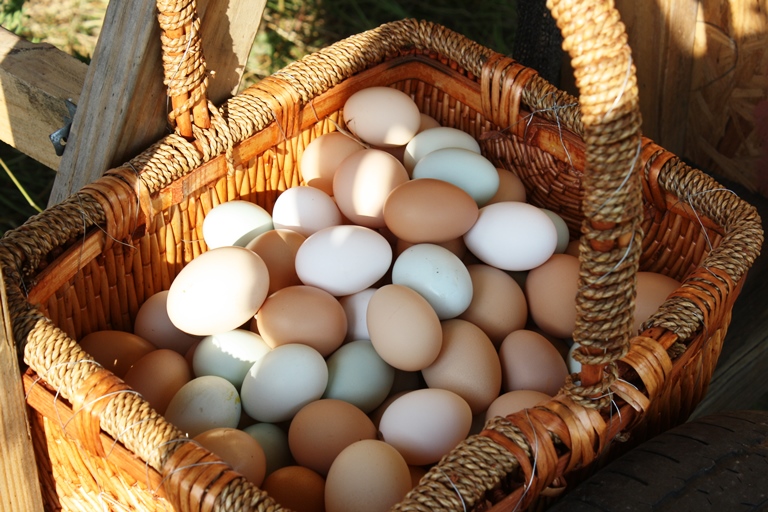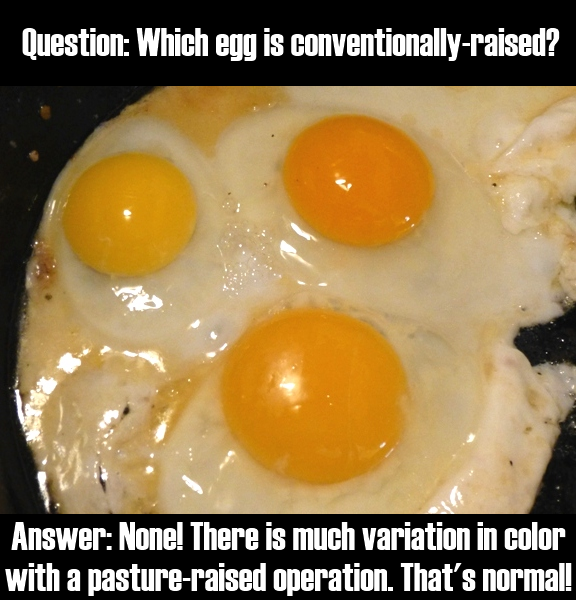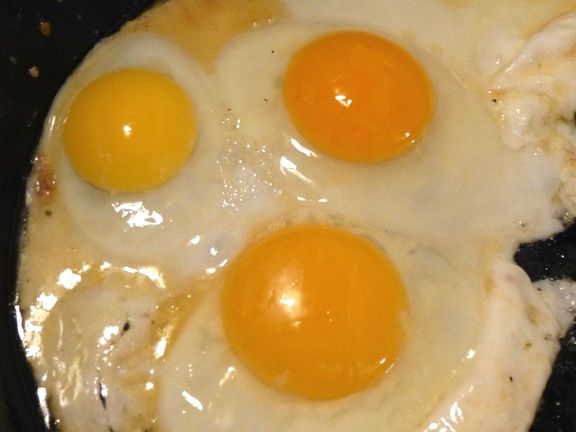An interesting little story came out last week about the day-to-day practices of a major brand of organic eggs. The article subtly criticized the confined quarters that offered no apparent access to outdoors, and gave readers some insight into how the actually-quite-deplorable practices still meet organic standards.
There will always be your occasional outbreaks of over-and-above corruption, like the CEOs who got caught repacking and selling expired eggs, which led to a food illness outbreak, and ultimately their imprisonment.
But that is not what this is.
This is just a brief and not-very-widely-reported peep under the veil of regular, approved, organic production that reveals not an acute problem, but a deep, festering, chronic misuse of customer trust and understanding.
Organic Egg Rules
Sure, the rules sound really good: access to fresh air, outdoors, direct sunlight, with “continuous total confinement indoors” being prohibited. But it is so easy to just have in mind to “check the boxes” of compliance, while missing the mark entirely. Anyone could make the case that 2-inch holes drilled in the side of a building at floor level provide “outdoor access” to the chickens because they can stick their heads out there. If you stuck your arm out a window, is your arm inside anymore? No! Of course not! So doesn’t that mean you now have “outdoor access?” If your arm could breathe, it would be breathing fresh air, wouldn’t it? You have to concede the argument.
But is that really meeting the intention of the standard?
What about the next provision? “Direct sunlight” sounds good, but then again, one could argue that this whole side of the building with the chicken-head-holes faces south and gets 6+ hours of sunlight per day. Not that the environment actually benefits from the sanitizing and Vitamin-D-enhancing properties of the sun…. Still–we have access to direct sunlight. Check!
I have it on good authority that a certain major organic egg producer complained that higher-ups were trying to force them to allow actual pasture access for their hundreds of thousands of hens. “That would require us to be buy more land, and it’s too expensive!”
Instead of thinking in terms of scaling down size and scaling up quality, the producer was only interested in figuring out how to fit the square peg into the round hole. Checking the boxes. Minimal compliance. Is that the kind of mindset you want for the person manufacturing your kids’ car seats or the roof of your house? But we so often accept this quality of management in our everyday consumption of nutrients by continuing to support these kinds of food systems. The best-but-cheapest eggs. The biggest green sticker on the package. The one with the most healthy-sounding claims.
This is a very convoluted issue, and the reason it will never be straightforward is because you can’t define standards specific enough to enforce true quality, without alienating 90% of good producers. Our various climates, land profiles, farm size, labor force, and ingenuity, necessitates highly customized solutions to pasture-based farm production. You really can’t even say how often the chickens ought to be moved because even that varies based on time of year, rainfall, hen age and breed, and paddock conditions.
I once wrote that running a farm is like flying a spaceship. Developing production standards specific enough to cover all scenarios would be like trying to write a step-by-step protocol for every maneuver your spacecraft and all its personnel might ever make during a trip to the moon. It can’t be done. There are simply too many variables. Even if it could be done, maybe it shouldn’t because it just might accidentally eliminate a really fabulous small-time farmer.
I know you’re busy and just need to know how to wisely feed your family. I could talk all day about this because it’s such an important and interesting issue, but I won’t bore you with the ponderings of a pasture-farmer. Here’s the takeaway, as pertains to eggs in particular:

Cage-Free Eggs
“Cage Free” means eggs were produced “by hens housed in a building, room, or enclosed area that allows for unlimited access to food [grain], water, and provides the freedom to roam within the area during the laying cycle.” Notice: no actual outdoor access of any kind. Does not address GMO feeding practices or drug use at all. Practically meaningless in the poultry world.
Free Range Eggs
The term “Free Range” requires “outdoor access” but does not define what that means. Remember your arm-out-the-window idea? Lots of abuse happens with this term. Does not address GMO feeding practices or drug use at all. Practically meaningless in the poultry world.
Organic Eggs
Slightly better than Free Range in terms of GMO feeding and drug use, but as seen above the the infamous example of the largest organic egg producer in the nation (supplying over 10% of the organic eggs sold in the USA!), it’s very easy to check the boxes and not actually have a substantially better product for the price.
Pasture-Raised Eggs
This one is dangerous because, just like “Grass-fed” for beef, it is considered a marketing term and is not officially defined or regulated. In the states where we are licensed to sell eggs, there is effectually no oversight regarding label claims, leaving it to whistleblowers to report on false advertising, which virtually never happens. Yes, we use this term because we feel the mental image it invokes is accurate to describe our operation, and we try to maintain transparency by allowing farm visits and answering consumer questions. But in practice, industry use of the “Pasture-Raised” term doesn’t speak to the conditions of the pasture, feeding standards (i.e. GMO or not), drug use, or rotation of the environment.
Why Animal Rotation Matters
If you’ve ever kept chickens or a dog in a small permanent outdoor “run,” you’ll understand that it doesn’t take very long for the “pasture” to turn to a manure-caked desert. Sure, the hens may actually be outside in cases like these, but we feel the main benefit to having hens on pasture is that they can consume living vegetation to increase their nutrition and detoxify their bodies (chlorophyll is an excellent detoxifier!).
But the chickens have to keep moving to new ground to keep the pasture healthy and growing, and that’s where it gets really complicated and expensive to produce eggs truly “on pasture,” especially for very large producers. Not saying it can’t be done on a large scale, but there are a LOT more hurdles to outdoor production than indoor. For example, the nest boxes have to be close to the chickens at all times. Chickens won’t walk to a barn from out in the pasture, so their coop has to move with them, and be large enough to provide roost space and shade during the heat of the day. But a traveling coop means you have to go out to the coop to get the eggs, then carefully haul them back in to where you can grade, candle, and package them. How do you drive across the pasture with thousands of eggs without breaking any?
Then there are considerations like getting water and food out to the chickens (no, contrary to popular belief, chickens can’t survive on grass alone–could you survive on only dry salad?), and keeping predators away from the hens. Everything LOVES to eat chicken. It takes some major thought to eliminate predation by owls, hawks, crows, skunks, opossums, coyotes, dogs, bobcats, bears, snakes, etc.
But even the deployed state of the adult chickens isn’t the only infrastructure question. You can’t put baby chicks in the same living conditions as adult hens and expect them to survive. They need warmth and protection from the elements, and an extra degree of predator protection. So you have to have separate facilities for babies, and then another living situation for the “teenagers” that haven’t begun laying yet, and perhaps are too small to stay inside a mobile net fence. And you have to move the hens from space to space as they grow up and have new and different needs. It takes 6 months to get that first egg. No wonder eggeries just keep them in a single building their entire lives. It’s just simpler.
How You Can Know For Sure
This concept of discussion applies to all aspects of natural livestock production, not just eggs. People want to know what brand is best because then they don’t have to think about it either–they can just check the box. But there is no one-size-fits-all answer to regulation of animal farming practices. This question bounces around constantly among pastured poultry producers, because it would be so much easier to have that one magic word to describe what it is that sets us apart from the rest. But some things have to be done the hard way, the old fashioned way. We can’t microwave this one.
I believe the best way to handle the accountability issue of food production is for you to find a farmer you can trust and build that relationship with. Local farmers are often excluded from the mainstream marketplace because there are many bureaucratic hurdles that a small-scale producer cannot overcome, and they need avid and loyal supporters to continue producing the superior quality products on a smaller, but better, scale.
You have a doctor, a lawyer, a mechanic, a pastor. Why not have your personal farmer, too?



